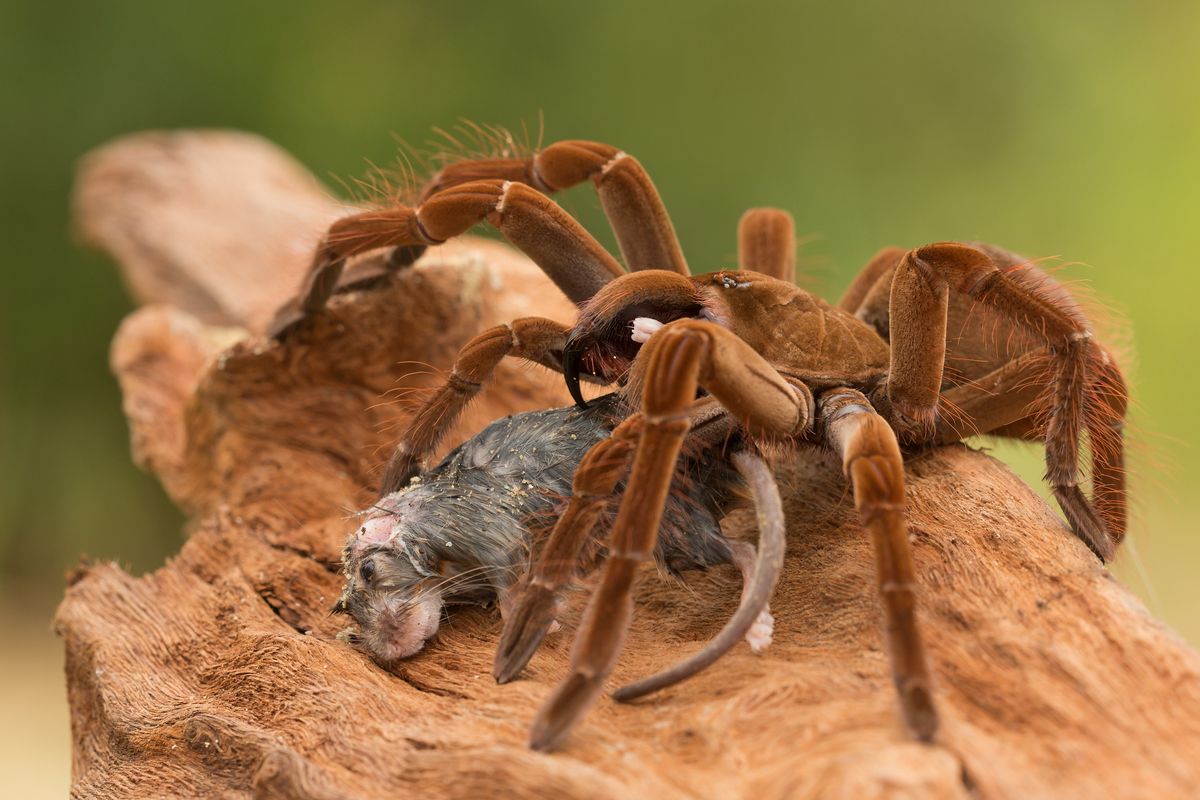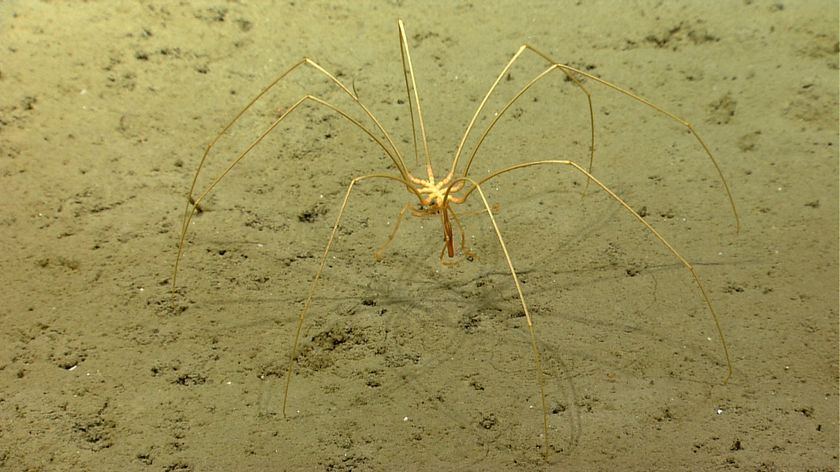
What is the biggest spider in the world?
From spiders the size of dinner plates, to others with inch-long fangs, these mythically-large arachnids roam the earth.

Throughout history, tales of giant spiders have gripped the human imagination — from Arachne, the half-woman, half-spider figure in Greek mythology to J'ba Fofi, the rumored monkey-size spider of the Congolese rainforest and Shelob, the monstrous arachnid who keeps Frodo the hobbit on his toes in "The Lord of the Rings."
But are there real-life spiders that inspired these stories and myths? What, in fact, is the biggest spider in the world?
While none are quite as enormous as those fictional beasts, the real world contains giant spiders galore. Just take giant huntsman spiders (Heteropoda maxima), which are the world's largest spiders by leg span. Measuring 11.8 inches (30 centimeters) across, these arachnids can reach the size of a dinner plate.
But another spider species is so large it's closer to the size of a puppy. "If we're talking about the largest species of tarantula, that would be a species called Theraphosa blondi," said Ray Hale, a wildlife lecturer, arachnologist and vice chairman of the British Tarantula Society. "That is, the goliath bird-eating spider."
Related: What is the deadliest spider in the world?
How big is it?
Most spiders can be split into two broad groups, Hale told Live Science: araneomorphs (also known as 'true spiders', a group that includes 90% of spiders on earth) and mygalomorphs. Tarantulas are mygalomorphs, a group that's considered more primitive than true spiders. This means that they have evolved less since ancient times, and have therefore maintained certain features that true spiders have since shed — such as downward-pointed fangs, and their large size.
This is why tarantulas feature the biggest spiders on Earth, including the West African Hercules baboon spiders (Hysterocrates hercules) — hefty creatures whose legs stretch to about 8 inches (20 cm); and face-size tarantulas Poecilotheria rajaei, which can also reach 8 inches in diameter and are native to Sri Lanka. Even larger are Brazilian salmon pink bird-eaters (Lasiodora parahybana), whose legs can reach 11 inches (28 cm).
Sign up for the Live Science daily newsletter now
Get the world’s most fascinating discoveries delivered straight to your inbox.
But none of these beat goliath bird-eaters, which live in dense rainforest in northern South America. While these spiders have slightly shorter legs than their huntsman cousins, stretching to 11 inches — their weight gives them the edge.
At 6.17 ounces (175 grams), and with bodies measuring 5.1 inches (13 cm), they are double the weight of their salmon pink relatives, making them the largest spiders in the world by mass. In 2014, an entomologist roaming the jungles of Guyana came across a goliath birdeater that was so big, it rustled the undergrowth and was equivalent in size to a young puppy — though a bit less cuddly, perhaps.
What does it eat?
The goliath bird-eater's name is a bit of a misnomer. "Yes, it is a big spider. Does it eat birds? Not really," said Hale. There are different theories on where the name came from. It was possibly inspired by a 19th-century engraving that showed these arachnids feasting on birds, while Hale said the name came from the accounts of 16th-century explorers to South America who put two-and-two together when they discovered some chicks that had fallen into the silk-lined burrows of this ground-nesting tarantula.
But Hale noted that while the nocturnal hunters might opportunistically pounce on vulnerable birds — and the occasional mouse — the bulk of their diet is made up of crickets, lizards and frogs. The spiders are near-blind, so they use extremely delicate bristles on their legs and abdomen to sense slight vibrations that guide them to their food. Their prey meet the sharp end of the tarantulas' 1 inch-long (2.5 cm) fangs, which inject a lethal amount of neurotoxic venom, followed by digestive juices that liquefy prey's tissues so that the spiders can slurp it up.
Goliath bird-eaters have their own predators, including snakes, wasps and humans — who report that the spiders have a delicious prawn-like flavor when roasted in banana leaves.
Is this spider harmful to humans?
Goliath bird-eaters are more likely to scurry away from a human than attack. And while there's nothing nice about receiving a nip from their needle-like fangs — an experience that's been compared to a wasp sting — their venom isn't potent enough to harm us. "You're not going to die from it. They're not dangerous," Hale said.
They do, however, have a secret weapon to ward off unwanted attention: By rubbing their hind legs against their abdomens, they release a flurry of hook-shaped bristles called "urticating hairs" that, once airborne, can become lodged in the skin and eyes and cause enough irritation to drive a predator away. That only happens after these spiders have delivered a warning: Threatened tarantulas will rub their front legs together to produce a high-pitched hissing sound that warns uninvited animals away. Called "stridulation," it's loud enough to be heard from up to 15 feet (4.6 meters) away.
And if that's not enough, these spiders can live for an extraordinarily long time. Along with their huge size, female goliath bird-eaters can live for up to 25 years, Hale said. Alongside the other wonders of their biology, this strikingly long lifespan is perhaps another reason that these behemoths deserve our respect and admiration, more than our fear.

Emma Bryce is a London-based freelance journalist who writes primarily about the environment, conservation and climate change. She has written for The Guardian, Wired Magazine, TED Ed, Anthropocene, China Dialogue, and Yale e360 among others, and has masters degree in science, health, and environmental reporting from New York University. Emma has been awarded reporting grants from the European Journalism Centre, and in 2016 received an International Reporting Project fellowship to attend the COP22 climate conference in Morocco.











